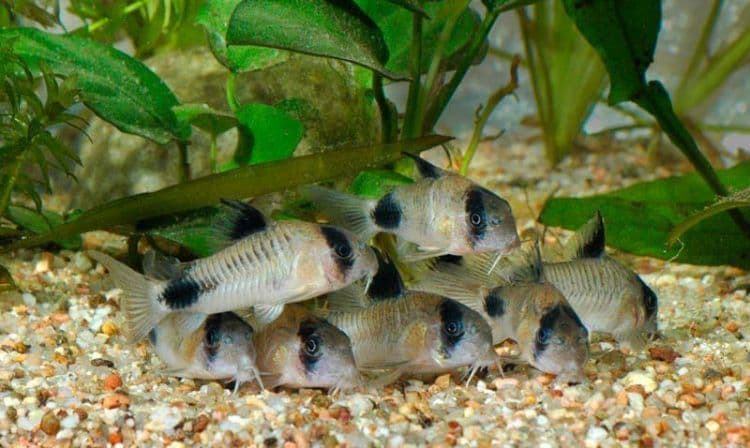
Last October I was at my favorite pet shop and happened upon four young Corydoras panda. To my mind these cats are really pretty. They are a shade of pink-orange with black markings on the dorsal fin, eyes, and caudal peduncle. The markings are what led to the name Panda Cory. They get to be 4.5 cm (1 3/4”) standard length. They originate from the Ucayali river system of Peru. Since I like most types of corys, I purchased all four.
I placed them in a ten gallon tank, that had a brown gravel as a substrate and was well planted with Amazon swords, Hygrophilia, and some Java moss. The pH was 7.0, hardness about 6 dH and the temperature was 25ºC (77ºF). I added a clay flower pot so they might have a hiding place to feel secure. Since these Corys were young I was hoping for a pair from the four.
I fed them a variety of foods: brine shrimp, blackworms, flake foods and some sinking disks. By January I noticed that one of the cats was thicker in the body and slightly larger than the others and assumed I had one female and three males; that’s not a bad ratio for breeding Corydoras species. About every 4-5 days I changed about a fourth of the water. In mid January I noticed the cats were very active with two of the males following the female around the tank. I did not observe the typical T-position that other Corys I have bred show. The following day there were 3 eggs visible on the glass (size of egg was 1.5mm, 1/16”) and I could see 2 more eggs in the Java moss – how many in total I could not tell, but I have read that the Panda cats are not prolific. I decided to leave the eggs and the parents together, as the adults seemed to ignore the eggs.
About 4 to 5 days later the eggs had hatched (I assumed) since the casings on the glass were empty. The fry, if there were any, must have dropped into the gravel, since they were nowhere to be seen. Three weeks later, I was rewarded with six little pandas hopping about on the bottom of the tank. The young were duplicates of the parents, cute as could be.
Since this first time I have removed the eggs and hatched them artificially using methylene blue as a fungicide. I still only find 10-12 eggs at a time. The fry hatch in about five days at 25ºC (6mm, 1/4” in size) and have a visible yolk sac that is absorbed in another two days. I feed the fry microworms for a couple of days and then switch to brine shrimp nauplii. The fry are active little buggers, and within two weeks they begin to show the panda pattern. By one month they are about 1.2 cm (1/2”) in length but much thicker than when they hatched. At two months they are 2.0 cm (3/4”).
These Corydoras panda are delightful little cats and as most Corys, sociable, so I would recommend if you see them available get at least 4-6 individuals for your tank.
Leave a Reply